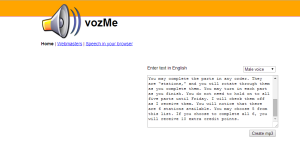Differentiated is something that is so important to the success of my students. As an alternative high school teacher, my students have gone through much of their educational career being pigeon-holed into certain typed of learning. It has been my goal since I started this journey as an alternative high school teacher to diversify my teaching and assessments as much as possible.
As I read through the key elements of differentiation, I realized that I use quite a few of them. Primarily, I focus a lot on the “process” of DI: with flexible grouping and classroom management benefiting all students and teachers. In a classroom with so many different learners and personalities, I rely on classroom management to do a lot of the work for me. I always start off my lessons by showing the students the types of activities and learning that we will do. I then continue on to say that just because someone doesn’t like one way or likes another way more doesn’t mean that either is wrong, and that we need to rely on respecting everyone to create the best learning environment. If someone wants to hinder that learning environment by being chronically disruptive and disrespectful, then they will never be able to harness what learning styles work best for them, as well as taking away from others in the room.
Another key concept that I use in each lesson is clarifying key concepts and generalizations. Because each of our brains work in so many different ways, we interpret the same information very differently. One thing we do before the lesson is talk about what we think key concepts mean, a sort of pre-assessment. Then once the lesson is completed, we discuss how our ideas changed, and why. If we have generalizations, why do we have generalizations? How can we change our thinking based on what we know and what we want to know?
One area that I need to focus on more in my classroom is Varying my expectations and requirements for student responses. Many times, I give my students a task and ask them to explore certain contexts, but my requirements for how they do this rarely change, and I realized that toward the end of last year they got stuck in their thinking and their approach to finding out information. I’d like to work on varying my expectations based on what I want them to realize about the standards/goals to meet.
Based on the WestEd article, something that I can use to support struggling learners in my classroom is computer based graphic organizers. While we use graphic organizers frequently on paper, this is a better approach to watching our learning change. What I really enjoyed was the idea of color-coding and adding arrows and pictures throughout the graphic orgs. These things could be easily changed (and shown on a time continuum) so we can see what we have learned and the progression of our learning through a visual and written format.
With the UDL Strategies Wiki, I chose the Current Events category. As a Social Studies teacher, I am always trying to bring current events and world information into my classroom. Besides teaching a Global Events class, I use current events and social situations frequently throughout my Civics and Economics classes. Even in my World History class, we frequently compare how old history relates to what is going on today, and tracing the path to how we got “here.” However, my students resist my use of current events in Civics and Economics (World History not so much). I’m sure it is how I am using them, but haven’t been able to incorporate them successfully. The Current Events UDL Tab has a few websites that display news in color format, and picture format, which seems a little less daunting than a newspaper or traditional online news source.
Finally, I used the Text-to-Audio Converter vozMe to create an audio file of a set of directions. This tool will support learners in my classroom because I have a few students who struggle with reading, and will often find any way to get out of it, but are great with verbal directions and information. This will help change their focus from getting information through visual text when they can now receive an audio text file.
This Thing incorporates many ISTE Standards and CITW Best Practices. Most specifically, I found that I must Facilitate and Inspire my students’ Learning through Designing and Developing Digital Learning Experiences and Assessments that are functional for all learners. When I can see how my students learn and work, I can design and differentiate my lessons around them. Once this happens, I hope to see their learning bloom and grow in different ways that they might not have even thought possible. In Best Practice, DI And UDL fits well in Cues, Questions, & Advanced Organizers, Summarizing and Notetaking, and Assigning Homework and Practice. By giving students different options in all aspects of my units and their learning, they can adapt how they take notes and practice information, which will focus their learning in ways that work best for them.


I did not know about the Current Events tab. That sounds pretty neat.